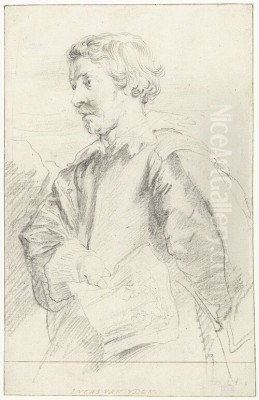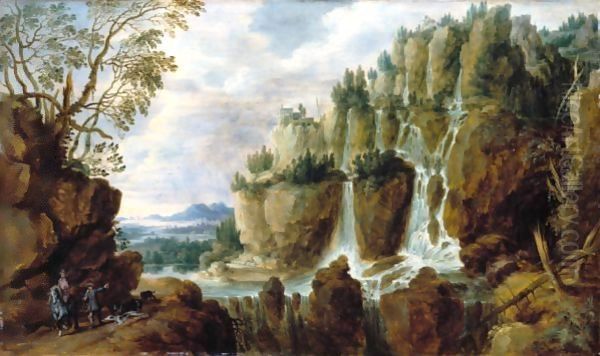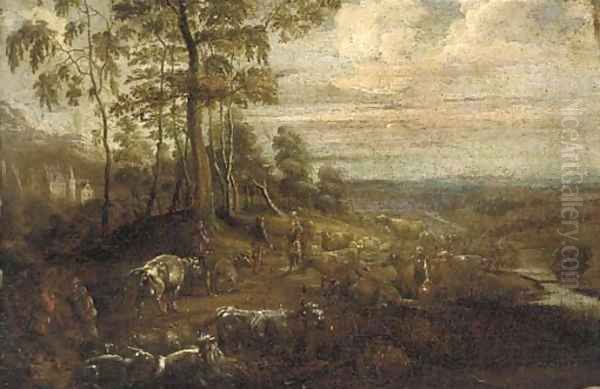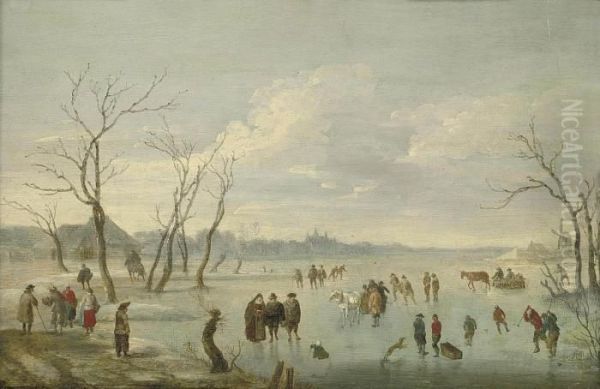
Lucas van Uden stands as a significant figure in the rich tapestry of 17th-century Flemish art. Born in Antwerp, the vibrant heart of Baroque painting in the Southern Netherlands, he dedicated his career primarily to the depiction of the natural world. As a painter and a highly skilled printmaker, particularly in etching, Van Uden carved a niche for himself, celebrated for his sensitive rendering of light, atmosphere, and the subtle moods of the landscape. His life and work unfolded during the dominant era of Peter Paul Rubens, an artist whose influence profoundly shaped the artistic landscape, including Van Uden's own development, yet Van Uden maintained a distinct and personal vision.
Early Life and Artistic Formation
Lucas van Uden entered the world in Antwerp on October 18, 1595. He hailed from an artistic milieu; his father, Artus van Uden, was recognized as Antwerp's city painter, suggesting an early immersion in the visual arts. This familial connection likely provided his initial training, a common practice in an era where skills were often passed down through generations within workshops. Formal records confirm his establishment within the city's artistic community when he was registered as a 'wijnmeester' (master's son) in the prestigious Guild of Saint Luke between 1626 and 1627. This status indicates he achieved mastery within the guild structure, benefiting from his father's membership.
While specific details about his formal apprenticeship under a particular master remain elusive, his upbringing within an artist's household and the environment of the Antwerp Guild provided a fertile ground for learning. The city itself was a crucible of artistic innovation, bustling with studios and artists like Jan Brueghel the Elder, known for his detailed landscapes, and Joos de Momper, another prominent landscape specialist. Van Uden absorbed the techniques and trends of his time, developing a foundation upon which he would build his unique style.
The Shadow of Rubens

It is impossible to discuss Lucas van Uden without acknowledging the immense presence of Peter Paul Rubens (1577-1640). Rubens dominated the Antwerp art scene, and his dynamic, colourful, and often dramatic style left an indelible mark on nearly all his contemporaries. Van Uden was no exception. His works frequently display a clear debt to Rubens, particularly in the structuring of his compositions and his approach to colour. The sweeping vistas, the arrangement of trees and landforms, and the vibrant, albeit often softer, palettes in Van Uden's paintings echo the landscape conventions popularized by the older master.
However, the precise nature of their relationship remains a subject of scholarly discussion. While the influence is undeniable, concrete evidence proving that Van Uden worked directly within Rubens's large and busy studio is lacking. Some historical accounts suggest he may have assisted Rubens, perhaps painting landscape backgrounds in the master's larger commissions, a common collaborative practice. Others propose that Van Uden primarily absorbed Rubens's style through careful study of his finished works, imitating his approach without formal employment in the workshop.
Regardless of the specifics, Van Uden actively engaged with Rubens's artistic language. Certain paintings by Van Uden are clear homages or adaptations of Rubens's compositions. For instance, Van Uden's painting known as A Cart Stuck (or similar titles depicting wagons in landscapes) shows a strong conceptual link to landscape paintings Rubens produced around 1635. This demonstrates Van Uden's close observation and assimilation of the prevailing Rubenesque aesthetic, even as he began to adapt it to his own sensibilities.
Artistic Style and Subject Matter
Lucas van Uden's primary focus was landscape. He excelled in depicting the Flemish countryside, often favouring wooded scenes, tranquil river valleys, and expansive plains dotted with villages or distant castles. His approach was characterized by a profound sensitivity to the effects of light and atmosphere. He possessed a remarkable ability to capture the specific quality of light at different times of day, from the cool clarity of morning to the warm glow of late afternoon. This focus on light became a hallmark of his style.
His paintings, particularly earlier works, often feature meticulous attention to detail. Leaves on trees, textures of bark, and distant architectural elements could be rendered with considerable precision. Yet, this detail was usually subordinate to the overall mood and atmospheric effect. He employed atmospheric perspective skillfully, using gradations of colour and clarity to create a convincing sense of depth and recession into space. Distant hills would fade into soft blues and greys, enhancing the illusion of vastness.

Compared to the often dramatic and energetic landscapes of Rubens, Van Uden's work frequently conveys a sense of calm and intimacy. His colour palette, while influenced by Rubens, tended towards softer harmonies, with delicate greens, blues, and earthy tones predominating. While capable of depicting grand panoramas, many of his most characteristic works are smaller cabinet paintings, inviting close contemplation. He sought to capture the poetic essence of the landscape, imbuing his scenes with a gentle, sometimes melancholic, lyricism.
Mastery in Printmaking
Beyond his paintings, Lucas van Uden was a highly accomplished printmaker, specializing in etching. His etchings were praised even during his lifetime and remain highly regarded for their technical finesse and artistic sensitivity. In this medium, perhaps even more than in his paintings, his mastery of light and shadow comes to the fore. He used fine lines and carefully controlled hatching to create subtle tonal variations, effectively translating the atmospheric effects he sought in paint into the graphic medium.
His etched subjects mirrored those of his paintings: wooded landscapes, river scenes, views with cottages or castles, and occasionally more expansive vistas like the Alpine Landscape. These prints often possess a remarkable freshness and immediacy. Some sources suggest a working habit that contributed to this: Van Uden reportedly rose at dawn to sketch directly from nature in the fields and forests around Antwerp. These plein air studies likely informed both his paintings and his prints, lending them authenticity.
His prints vary in character. Some are small, intricate compositions packed with detail, while others display broader, more suggestive handling. Certain etchings exhibit strong contrasts between light and dark areas, perhaps again reflecting the influence of Rubens's dramatic chiaroscuro, adapted to the linear constraints of etching. While collaboration details are scarce, it's noted he worked alongside other printmakers, potentially including figures like Adriaen van de Heyn, further embedding him within Antwerp's graphic arts network. His contribution to Flemish printmaking is significant, pioneering delicate landscape etching alongside contemporaries exploring other genres.
Representative Works
Several works exemplify Lucas van Uden's style and preoccupations. A Cart Stuck (or Wagon Stuck in the Mud) is frequently cited. This composition, known through paintings and an etching by Van Uden himself, depicts a rustic scene where effort and nature intersect. It clearly shows the influence of Rubens's late landscapes but is imbued with Van Uden's characteristic handling of light, often contrasting a brightly lit area with a deeply shaded one, creating visual and narrative tension. The etching associated with this theme helped solidify its attribution to Van Uden, distinguishing it from initial assumptions linking it directly to Rubens.

The etching Alpine Landscape showcases his ability to handle grander, more imaginary scenes, perhaps inspired by prints or paintings by artists who had travelled south, like Paul Bril. It demonstrates his skill in rendering mountainous terrain and atmospheric depth within the confines of the etched line. Similarly, Wooded Landscape with a House by a River represents his more typical Flemish subjects, capturing the tranquil beauty of the local countryside with sensitivity to foliage, water, and light.
His Castle Landscape etchings explore the integration of architecture within the natural setting, balancing man-made structures with the surrounding trees, water, and sky. Across his oeuvre, whether in oil, watercolour, or etching, Van Uden consistently returned to the theme of nature observed, filtered through his gentle, light-sensitive artistic temperament. His works often included small figures, sometimes added by collaborators, which helped to animate the scenes and provide scale.
Collaborations and Studio Practice
Collaboration was a standard practice in 17th-century Antwerp's efficient art market. Specialists often teamed up, with landscape painters providing backgrounds for figure painters, or vice versa. Lucas van Uden participated actively in this system. He is known to have collaborated with prominent figure painters, who would add the staffage (human figures and animals) to his landscapes.
Most notably, he worked with David Teniers the Younger (1610-1690), a master of genre scenes and peasant life. Teniers' lively figures populate many of Van Uden's landscapes, creating a harmonious blend of their respective specialities. He also collaborated with the great Jacob Jordaens (1593-1678), another leading figure painter in Antwerp alongside Rubens and Anthony van Dyck (1599-1641). These collaborations enriched Van Uden's compositions, adding narrative elements and human interest to his natural settings. Other artists known for collaborations in Antwerp included animal and still-life specialists like Frans Snyders (1579-1657) and landscape painters like Jan Wildens (1586-1653), highlighting the interconnectedness of the artistic community.
Van Uden also operated his own studio and took on apprentices, fulfilling his role within the Guild structure. His son, Jacob van Uden, followed him into the profession and was registered as his apprentice. Records also mention grandsons and the sons of Jean-Baptiste Bonnecoeur learning under his guidance. This indicates the transmission of his skills and style to the next generation, ensuring a continuity of the landscape tradition within his own family and workshop. His documented habit of early morning sketching suggests a disciplined approach and a deep commitment to observing the natural world firsthand.
Travel and Later Life
While Antwerp remained his primary base for most of his life, Van Uden did undertake some travel. Records suggest he journeyed along the Rhine River between 1644 and 1646. Such trips were often undertaken by artists for inspiration, offering new vistas and motifs. The landscapes of the Rhine valley, with their castles, hills, and river views, may have provided fresh material or reinforced his interest in picturesque compositions.
Around 1649, there is evidence suggesting he may have temporarily left Antwerp, possibly residing in Brussels for a period before returning. The reasons for this move are unclear but could relate to patronage opportunities or personal circumstances. His personal life included his marriage to Anna van Woelput, who herself came from an artistic background. The continuation of the artistic profession through his son Jacob ensured the Van Uden name remained associated with painting in Antwerp. Lucas van Uden passed away in his native city on November 4, 1672, leaving behind a substantial body of work.
Influence and Legacy
Lucas van Uden occupies an important place in the history of Flemish landscape painting. While working somewhat in the shadow of the towering figure of Rubens, he developed a distinct and influential voice. His emphasis on light, atmosphere, and the quiet moods of nature distinguished his work. He is considered one of the key figures who helped establish landscape as a specialized and respected genre in the Southern Netherlands, moving beyond its earlier role as mere background for historical or religious scenes.
His influence extended through his paintings and, significantly, through his etchings. These prints circulated widely, disseminating his style and approach to landscape representation. His delicate etching technique and focus on atmospheric effects were particularly innovative and earned him recognition as a pioneer in Flemish landscape etching. Some later observers have even characterized his light-filled, atmospheric approach as anticipating aspects of 19th-century Impressionism, though this is an anachronistic comparison, it highlights his forward-looking sensitivity to capturing transient natural effects. He built upon the legacy of earlier landscape specialists like Gillis van Coninxloo while forging his own path.
Despite his achievements, some ambiguities remain. The exact nature of his interaction with Rubens's studio continues to be debated by art historians. Attribution issues occasionally arise, with some works hovering between Van Uden, his followers, or even misattributions to Rubens himself, underscoring the strong stylistic connections of the era. Furthermore, the question of external influences, perhaps from Italianate landscape traditions known through prints, on his printmaking style invites further study. His stylistic evolution from detailed early works to broader, more atmospheric later pieces reflects a common artistic trajectory but its specific catalysts remain open to interpretation.
Conclusion
Lucas van Uden remains a compelling figure in 17th-century Flemish art. As a dedicated landscape painter and a masterful etcher, he made significant contributions to the genre. His ability to capture the subtle interplay of light and atmosphere, combined with a deep appreciation for the Flemish countryside, resulted in works of enduring charm and sensitivity. While profoundly influenced by the dominant style of Rubens, he forged a personal artistic identity focused on the lyrical and intimate aspects of the natural world. Through his collaborations, his teaching of apprentices including his own son, and the circulation of his admired prints, Van Uden left a lasting mark on the development of landscape art in Flanders and beyond. His paintings and etchings continue to be appreciated for their technical skill, their quiet beauty, and their evocative portrayal of nature.